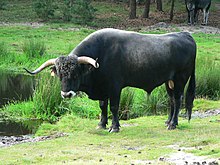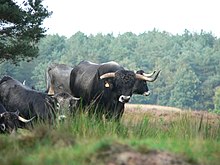Tudanca cattle




The Tudanca is a traditional Spanish breed of
Appearance and description
Tudanca is a middle-sized cattle breed, with cows reaching 135 cm shoulder height and a weight of 320 kg, bulls reaching 150 cm and 420 kg. The colour of Tudanca goes from greyish to black,[6] cows are lighter than bulls on average. Like the aurochs, Tudanca bulls have a light stripe on their back. Additionally, they often have a light saddle. Typically for Tudanca is the swung back line, which is strongly pronounced in bulls. The cows are smaller and more gracile than the bulls. The long horns of Tudanca are variable, they can be either aurochs-like or swung outwards. Tudanca bulls often carry long curly hair on their front head, which is a feature also described for the aurochs.
Range and use
Tudancas were formerly used in inner Cantabria as work animals in the field, but after the mechanization of agriculture, the breed was listed as protected
Tudancas are used by the
Gallery
-
Tudanca bull in Johannahoeve, Netherlands.
-
Couple of cows working at the grass crop inSaja valley, Cantabria, in 1983.
-
Tudancas competing in a dragging test in the Day of Cantabria.
See also
- Aurochs
- TaurOs Project
References
- ISBN 9789251057629. Accessed January 2017.
- ^ Breed data sheet: Tudanca / Spain (Cattle). Domestic Animal Diversity Information System of the Food and Agriculture Organization of the United Nations. Accessed July 2020.
- ISBN 9789054390176.
- ^ Raza bovina Tudanca: Datos Generales (in Spanish). Ministerio de Agriculturo, Pesca y Alimentación. Accessed July 2020.
- ^ Raza bovina Tudanca: Datos Morfológicos (in Spanish). Ministerio de Agriculturo, Pesca y Alimentación. Accessed July 2020.
- ^ a b c d http://www.iberianature.com/material/cows.html Spanish cows and beefs
- ^ ISBN 9788449109461.
- ^ ISBN 9781780647944.
- ^ a b El Diario Montañés (1 January 2010). "Las cabezas de ganado tudanco crecieron un 30% en diez años" (in Spanish).
- ^ Bunzel-Drüke, Finck, Kämmer, Luick, Reisinger, Riecken, Riedl, Scharf & Zimball: "Wilde Weiden: Praxisleitfaden für Ganzjahresbeweidung in Naturschutz und Landschaftsentwicklung
- ^ http://www.stichtingtaurus.nl/cStdPage.php?ref=54&userID=84a8818d6ca464282b76af6952d97d46 Stichting Taurus
External links
- http://www.infocarne.com/bovino/raza_tudanca.htm
- http://www.stichtingtaurus.nl/
- http://www.feagas.com/index.php/es/razas/bovino/tudanca



